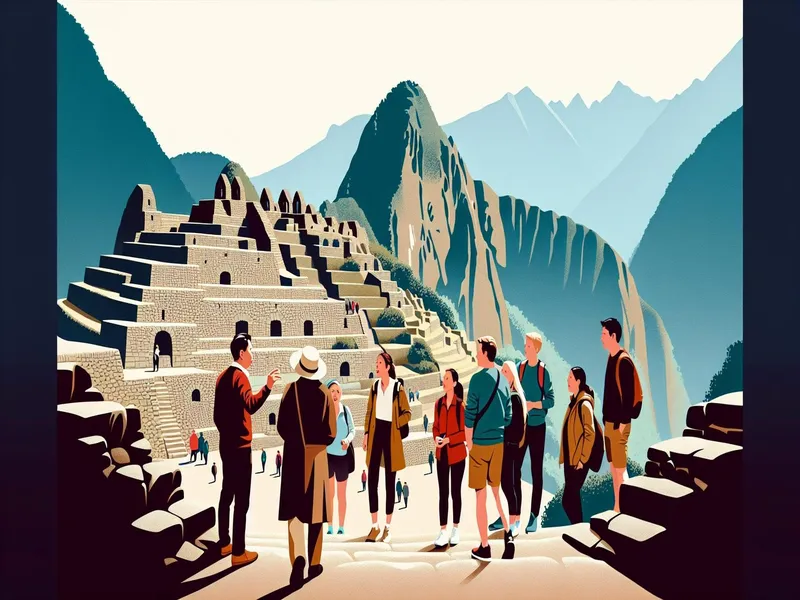
Whether you’re a student seeking academic enrichment or a lifelong learner eager for new experiences, this continent has something unique to offer.
Ignoring the potential of educational travel means missing out on transformative experiences that can broaden your worldview and enhance your personal growth. Without it, you might find yourself stuck in traditional learning environments that don’t fully engage or inspire you.
I’ve spent years exploring South America’s rich world of educational opportunities. From archaeological sites in Peru to ecological studies in the Amazon rainforest, I’ve seen firsthand how these experiences can enrich one’s understanding of the world.
Different travelers have different needs—students may look for structured programs while solo adventurers might prefer flexible itineraries. No matter what you’re after, there’s a perfect fit waiting for you here.
What Is Educational Travel?
Educational travel is more than just sightseeing; it’s about diving deep into the essence of a place. Think of it as learning without walls or textbooks, where every corner you turn holds a lesson waiting to be discovered.
When I first explored South America, I realized how educational travel can transform your perspective. It’s not just visiting Machu Picchu—it’s understanding the ancient Incan civilization that built it. Imagine walking through the Amazon Rainforest and learning firsthand about its biodiversity from local guides who know every plant and animal by heart.
Why Choose Educational Travel?
- Immersive Learning: You get to learn directly from the source. Instead of reading about the Galápagos Islands in a classroom, you can actually see giant tortoises and understand their ecosystem.
- Cultural Exchange: Interact with locals, participate in traditional ceremonies, or even try cooking local dishes. These experiences are priceless compared to any textbook knowledge.
- Language Skills: Traveling through Spanish-speaking countries like Argentina or Chile helps you practice and improve your language skills naturally.
Types Of Educational Travel
- Structured Programs: These are organized tours often led by experts in fields like archaeology or biology. For example, a guided tour around Peru’s archaeological sites with an archaeologist explaining each site’s significance.
- Flexible Itineraries: If you’re someone who prefers going off the beaten path, you can create your own itinerary focused on specific interests like art history in Colombia or wine production in Mendoza.
- Voluntourism: This combines volunteering with tourism, allowing you to give back while learning. Picture yourself helping out at a wildlife sanctuary in Ecuador while gaining insights into conservation efforts.
Real-Life Examples
I remember my trip to Bolivia where I joined a program studying Andean cultures. We lived with local families, learned traditional weaving techniques, and participated in community rituals. It felt like stepping into another world.
Or take my visit to Brazil’s Pantanal region—the world’s largest tropical wetland—where we tracked jaguars with biologists! These hands-on experiences stick with you far longer than any lecture ever could.
- Research Destinations: Look for places rich in cultural heritage and natural beauty.
- Select A Program Or Create Your Own Plan: Depending on whether you prefer structure or flexibility.
- Prepare Mentally And Physically: Some trips might require good physical condition especially if they involve hiking or other strenuous activities.
- Engage Actively During The Trip: Ask questions engage with locals immerse yourself fully!
Why Choose South America for Educational Travel?

South America offers a wealth of opportunities for educational travel. Whether you’re into history, nature, or languages, this continent has something unique to offer.
Diverse Cultures and Histories
South America’s cultures and histories are incredibly diverse. Imagine walking through ancient ruins in Peru or visiting vibrant markets in Bolivia. Each country tells its own story. For instance, Machu Picchu isn’t just a tourist spot; it’s an open-air classroom on Incan civilization. Exploring cities like Buenos Aires can teach you about colonial history and modern urban culture simultaneously. The continent’s blend of indigenous traditions and European influences creates a rich world that’s both fascinating and educational.
Rich Biodiversity and Natural Wonders
The biodiversity in South America is unparalleled. Think about the Amazon Rainforest—it’s like stepping into a living biology textbook! You can learn about countless species of plants, animals, and insects you won’t find anywhere else. I once spent time with local guides studying river dolphins in Brazil; it was mind-blowing how much knowledge they had about their ecosystem. From the Andes Mountains to Patagonia’s glaciers, natural wonders abound here, offering endless learning opportunities for ecology enthusiasts.
Top Destinations for Educational Travel in South America

When it comes to educational travel, South America offers a treasure trove of experiences. Let’s jump into some must-visit destinations that promise not just learning but also unforgettable adventures.
Peru: The Land of the Incas
Peru is like stepping into a history book. Picture yourself walking through the ancient ruins of Machu Picchu, surrounded by breathtaking mountain views. This iconic site isn’t just about the stunning scenery; it’s an incredible lesson in Incan engineering and culture. I remember hiking the Inca Trail and feeling like I was part of something much bigger than myself.
But don’t stop there! Cusco, once the capital of the Inca Empire, is a living museum with its cobblestone streets and vibrant markets. You can even take language classes while soaking up the local culture. Trust me, practicing your Spanish while bargaining at San Pedro Market adds a whole new dimension to learning.
Brazil: A Melting Pot of Cultures
Brazil’s diversity will blow you away. It’s like attending a world fair without leaving one country. From the samba rhythms in Rio de Janeiro to capoeira (a Brazilian martial art) demonstrations in Salvador, there’s always something new to learn here.
One time, I joined a cooking class in Bahia and learned how to make moqueca, a traditional fish stew. The process taught me more about Afro-Brazilian culture than any textbook ever could. And let’s not forget the Amazon Rainforest! Guided tours offer insights into unique ecosystems, wildlife conservation efforts, and even medicinal plants used by indigenous tribes.
Argentina: European Flair in South America
Argentina feels like a slice of Europe transported to South America with its Parisian-style cafes and grand architecture in Buenos Aires. But it’s also steeped in rich histories like Eva Perón’s legacy or tango music’s evolution.
I attended a history lecture at Recoleta Cemetery—yes, where Evita rests—and it was as engaging as any classroom back home. Plus, visiting Patagonia offers lessons on geology and biodiversity amid jaw-dropping natural landscapes.
Ecuador: The Gateway to the Galapagos
Ecuador might be small but packs an educational punch, especially when you hop over to the Galapagos Islands—the ultimate biology classroom! Charles Darwin’s theories come alive when you see giant tortoises lumbering around or blue-footed boobies performing their quirky mating dance.
During my trip there, we had marine biologists guiding us through snorkeling sessions where we swam alongside sea lions and colorful fish schools—a real-life Finding Nemo adventure! Back on mainland Ecuador, don’t miss Quito’s historic center for lessons on colonial history blended with modern-day culture dynamics.
In these places across South America, every corner turns into an opportunity for immersive learning that textbooks simply can’t replicate.
Types of Educational Activities
Educational travel in South America offers a wealth of opportunities for immersive and transformative learning experiences. Let’s explore some popular types.
Cultural Immersion Programs
Cultural immersion programs let you dive deep into the local way of life. Imagine spending a few weeks living with an indigenous community in Peru, learning their traditions, language, and daily routines. These programs often include activities like cooking traditional dishes, participating in local festivals, or even learning ancient crafts. For instance, I spent two weeks in Bolivia with the Quechua people, where I not only learned to weave intricate textiles but also gained invaluable insights into their history and culture.
Environmental Conservation Projects
Environmental conservation projects are perfect for nature lovers who want to make a difference while traveling. Picture yourself in the Amazon Rainforest working alongside biologists to protect endangered species or restore habitats. You might participate in activities like planting trees, monitoring wildlife populations, or educating locals about sustainable practices. During my time in Brazil’s Pantanal region, I helped track jaguars as part of a conservation project; it was both thrilling and educational.
Academic Exchange Programs
Academic exchange programs offer structured educational experiences through partnerships between institutions. These can range from semester-long university exchanges to short-term study tours focused on specific subjects like archaeology or marine biology. If you’re studying Spanish literature at university, imagine spending a semester at the National University of San Marcos in Lima—one of the oldest universities in the Americas—immersing yourself in both academic studies and Peruvian culture.
Preparing for Your Educational Trip
You’re on the verge of an eye-opening adventure in South America. Let’s make sure you’ve got everything set before diving into this life-changing experience.
Visa and Travel Requirements
First things first, check visa requirements. Each country in South America has its own rules. For example, US citizens can visit Brazil for up to 90 days without a visa but need one for longer stays or activities like working or studying.
Make sure your passport is valid for at least six months beyond your travel dates. Some countries might not let you in otherwise. Double-check airline rules too—some will deny boarding if your passport doesn’t meet these criteria.
Here’s a quick checklist:
- Passport: Valid for six months
- Visa: Check individual country requirements
- Return Ticket: Sometimes required to prove you’ll leave the country
Health and Safety Tips
Staying healthy and safe is crucial. Vaccines like yellow fever are mandatory for some areas, especially if you plan to explore the Amazon Rainforest. You don’t want to be caught off guard by local health regulations.
Pack a basic first-aid kit with essentials like band-aids, antiseptic wipes, and any prescription meds. Trust me, having these handy can save you from minor inconveniences becoming trip spoilers.
Consider these safety tips:
- Vaccinations: Yellow fever, Hepatitis A/B
- First-Aid Kit: Band-aids, antiseptics
- Local Emergency Numbers: Save them on your phone
Budgeting and Fundraising
Educational travel isn’t cheap but don’t let that deter you! Start budgeting early by listing out potential expenses—flights, accommodation, food, excursions. Websites like Numbeo give average costs of living in different cities which helps.
Fundraising can also ease financial strain. Crowdfunding platforms (like GoFundMe) are great places to share your journey’s purpose with friends and family who may want to contribute.
- List Expenses: Flights, accommodation
- Use Tools: Numbeo for cost estimates
- Crowdfund: Share on GoFundMe
In Closing
Educational travel in South America offers unparalleled opportunities to immerse oneself in diverse cultures, languages, and histories. Each journey allows for a deeper understanding of the world beyond textbooks.
Whether exploring ancient ruins in Peru or studying unique ecosystems in the Amazon, this form of travel provides transformative learning experiences. The insights gained from local guides and hands-on activities can profoundly impact personal growth.
South America’s rich biodiversity and cultural heritage make it an ideal destination for educational adventures. So why settle for traditional learning when you can begin on a journey that broadens your horizons and enriches your life?